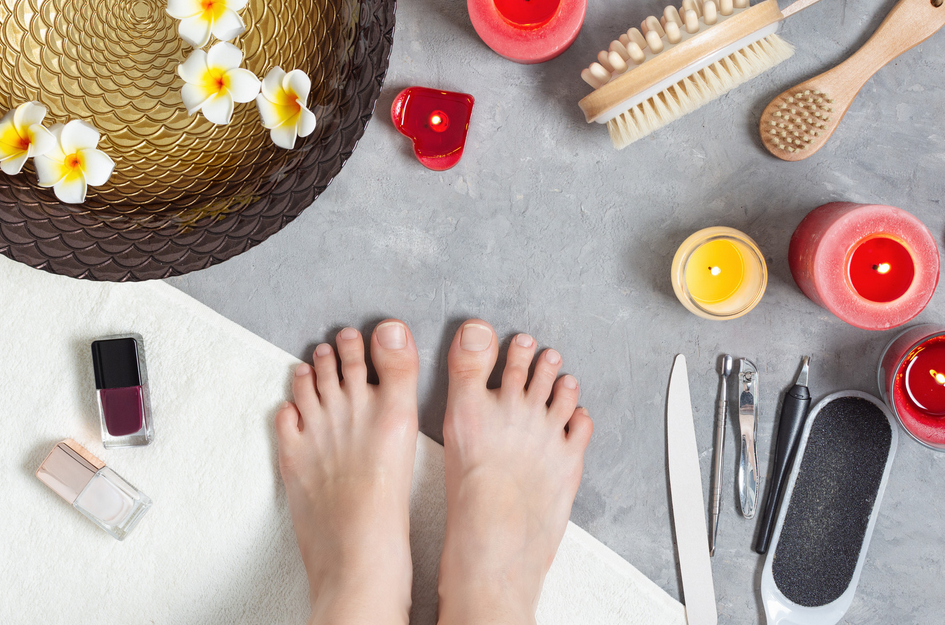Pedicures are everyone’s favorite self-care treat. But they’re not just an extravagant way to relax, they’re a key part of maintaining good foot health. To keep healthy and happy feet, it’s important to get regular pedicures. In fact, many foot conditions are associated with poor foot hygiene and care, like calluses, corns, fungal infections, and Athlete’s foot.
So take care of your feet, and treat yourself with a pedicure! In this article we’re going to cover everything you need to know about pedicures. What they are, why they’re used, how often to get them, and whether a salon is better than an at-home pedicure. Keep reading to get to the bottom of this foot care method.
What are pedicures?

A pedicure is a cosmetic treatment that is done on the feet and toenails. According to Wikipedia, the two main benefits are cosmetic and therapeutic. However, the foot experts here at FitMyFoot would tend to disagree. While these are two major benefits that can’t be ignored, the benefits of pedicures go way beyond how they make your feet look and feel.
Pedicures can be medical interventions that help to prevent and treat common foot conditions.
Why are pedicures beneficial?
If you’re looking for some motivation to get a pedicure, here it is. Many foot conditions like corns, calluses, fungal nail infections, ingrown toenails, verrucae, Athlete's foot, and hard skin are all improved by receiving regular pedicures. That’s why podiatrists recommend regular pedicures as a component of any treatment plan.
These conditions can cause pain, discomfort, or embarrassment. You may want to hide your feet from the world, for fear of being judged. That’s no way to live! Luckily, taking better care of your feet can prevent these conditions from occurring, and help them get better naturally.
You can also get a medical pedicure directly from a podiatrist. This is specifically for people who have been diagnosed with a foot condition that may prevent them from benefiting from an at-home or salon treatment.

During this, a podiatrist will make an assessment of your feet and provide tailored care. This noninvasive treatment focuses on the hygienic and aesthetic care of the toenails and soles of the feet. It may include massage to increase blood flow and circulation, remove hard skin or calluses, and cutting toenails in a way to minimize ingrown toenails from reforming.
Aside from these benefits, you will also experience relaxation, stress-relief, and enjoy the cosmetic outcome of clean, beautified feet. It’s vital to take care of yourself, and getting a pedicure shouldn’t be viewed as an unnecessary luxury. But rather, it’s a way to practice self-care and reduce the risk of developing foot conditions that can be a hindrance further down the line.
What happens during a pedicure?
A standard pedicure will include foot soaking, foot exfoliation, nail clipping, nail shaping, foot and calf massage, moisturizer and nail polishing. Often the callus smoothing, nail shaping, and cuticle cleaning are all performed with an electric file.

The first phase, the foot soaking, helps to soften the skin on the feet. The skin on the feet is harder than other areas in the body, so can be tough or appear to be dry and cracked. Softening the skin can help to reduce and prevent Athlete’s foot, alleviate toenail fungus, reduce swelling, and ease the pain of prolonged standing or high-impact exercise.
After this, once the skin is soft, it’s easier to exfoliate the dead skin away. This might be done with a pumice stone or foot file that looks similar to a cheese grater. Regularly removing the dead skin from your feet has benefits including reducing the risk of calluses, avoiding clogged pores, minimizing infection risk, and being left with smooth, supple feet.
You may be given the option to paint your toenails at the end of the pedicure if you have it done in a salon, but this isn’t a necessity. Many men and women choose to get pedicures simply for the medical benefits and do not wish to receive any cosmetic enhancements from nail polish.
Shop Premium Custom Insoles
How often should you get pedicures?
You should aim to get a pedicure every four to six weeks. This is the amount of time it takes for dead skin to form on the feet, so targeting this before it worsens can be beneficial.
Are salon pedicures better than at-home pedicures?
Getting a pedicure every month in a salon might be costly. So you may be wondering whether you can do a pedicure at-home. The answer is yes! You can buy the equipment for at-home pedicures very cheaply and can watch YouTube videos on how to perform the task yourself.
That being said, getting your feet pedicured by a professional can have a better outcome. Not only will you feel more relaxed, you may get better results. This is particularly true if you have foot conditions that require an expert to treat.
When should you avoid pedicures?
According to a podiatrist at Michfoot Surgeons, there are instances in which you should avoid pedicures. These include:
1. Diabetic foot issues - If you have neuropathy or diabetes, you are more at risk of foot-related complications. It’s best to check with a podiatrist before visiting a salon or trying to tackle your foot issues by yourself.
2. Toenail fungus - Toenail fungus is highly contagious. If you bring this to a salon, it can have a serious impact on the other customers if it spreads. Tell-tale signs of fungus include thick, yellow, or raised toenails.
3. Immunocompromised individuals - Salons do increase your exposure to bacteria and fungus, so instead, do your pedicure at-home!
4. After toenail injury - If you have experienced toenail injuries, it’s better to let your toenails recover rather than treating them with a pedicure.

